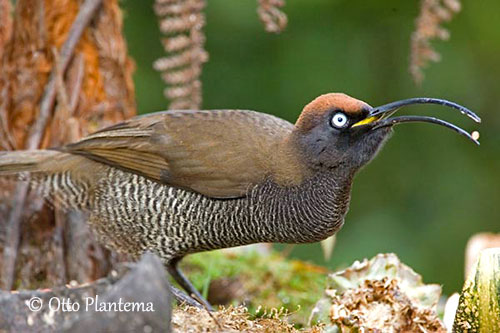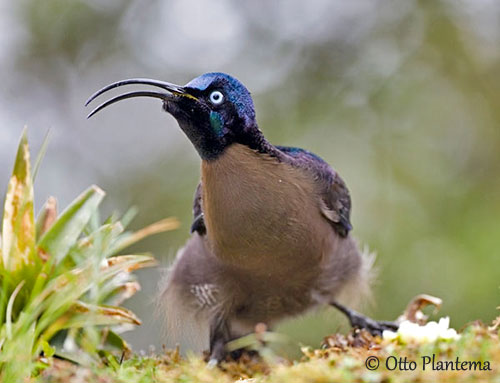
PROTECTION / THREATS / STATUS:
The Brown Sicklebill is described as quite common over much of its range. It is probably patchily distributed in some parts of the distribution, and the species has declined due to plume-hunting in some highland regions.
The population size is unknown, but it is suspected to be stable.
The Brown Sicklebill is currently evaluated as Least Concern.
Fr: Paradisier de Meyer
Ang: Brown Sicklebill
All: Braunbauch-Paradieshopf
Esp: Ave del Paraíso de Meyer
Ita: Falcibecco bruno
Nd: Bruine Sikkelsnavel
Sd: brun bågnäbbsparadisfågel
Photographers:
Otto Plantema
Trips around the world
Dubi Shapiro
Dubi Shapiro Photo Galleries
Text by Nicole Bouglouan
Sources:
HANDBOOK OF THE BIRDS OF THE WORLD Vol 14 by Josep del Hoyo-Andrew Elliot-David Christie - Lynx Edicions – ISBN: 9788496553507
Les Oiseaux de paradis – Histoire Naturelle et photographies - par Michel Ottaviani - Editions Prin, France – ISBN : 2-909136-40-X
Birds of Paradise and Bowerbirds De Phil Gregory – Editeur: Bloomsbury Publishing, 2020 – ISBN: 1472975847, 9781472975843 – 416 pages
Birds of New Guinea: Second Edition De Thane K. Pratt, Bruce M. Beehler – Editeur: Princeton University Press, 2014 – ISBN: 0691095639, 9780691095639 – 528 pages
Birds of New Guinea: Distribution, Taxonomy, and Systematics De Bruce M. Beehler, Thane K. Pratt – Editeur: Princeton University Press, 2016 – ISBN: 069116424X, 9780691164243 – 672 pages
The Complete Birds of the World: Every Species Illustrated De Norman Arlott, Ber van Perlo – Editeur: Princeton University Press, 2021 – ISBN: 0691193924, 9780691193922 – 640 pages
The (un)reasonable beauty: What factors shaped the evolution of Paradisaeidae?
CREAGUS@Monterey Bay (Don Roberson)
Fatbirder - The World’s Richest Information Resource about Birds for Birders
Wikipedia, the free encyclopaedia
Brown Sicklebill
Epimachus meyeri
Passeriformes Order – Paradisaeidae Family
INTRODUCTION:
The Brown Sicklebill is found in the central mountain range of New Guinea, from WC to SE. It can be seen in mountain forest and forest edges.
It is the second member of the genus Epinachus, the other species being the Black Sicklebill. Both species show marked sexual dimorphism.
The Brown Sicklebill feeds on fruit, arthropods and insects, caught by probing and tearing of dead wood.
The male is polygynous. At the beginning of the breeding season, it performs elaborate displays including various postures to enhance its beautiful plumage. The nest is built by the female alone, a shallow bowl placed 4-12 metres above the ground in small tree.
Both scientific and French names pay tribute to Adolf Bernhard Meyer, one of the authors of the bird description.
The Brown Sicklebill is described as common to abundant in most of the range, and the species is not globally threatened.

DESCRIPTION OF THE BIRD:
Biometrics:
Length: M: 49 cm (96 cm including the tail) – F: 52 cm
Weight: M: 144-310 g- F: 140-202 g
The Brown Sicklebill adult male has black upperparts with green-blue and/or magenta sheens on mantle and back. On central back, the iridescent, metallic blue-green feathers form a conspicuous scaled pattern. We can see a purple gloss on the rump.
The black upperwing shows variable blue-green, blue or purple gloss. The long, graduated tail has elongated, sabre-shaped central rectrices. The uppertail is brownish-black with blue iridescent sheen on the outer webs. The central rectrices are iridescent, metallic green-blue and /or magenta.
On the underparts, the breast is dark brown, strongly washed with purple on the sides. We can see ornamental black feathers with metallic dark magenta iridescence, and the shorter overlying feathers show broad, iridescent blue, purple and/or violet tips.
On the sides of breast, belly and vent, there are elongated, modified feathers with iridescent purple and/or magenta, broad (but tapering) tips. Other sparse, filamentous, fawn-brown plumes show paler, central shafts. Both vent and undertail-coverts are olive-brown.
The entire head is black, but depending on the light, crown and face may show scale-like feathers with metallic green-blue iridescence and purple/magenta washes.
Chin, throat and neck are black with iridescent magenta feather tips.
The black bill is long, sickle-shaped (giving the bird its name) and the mouth is bright yellow. The eyes are pale blue. Legs and feet are dark grey to blackish.

The female is smaller than male, especially the tail. She has very different appearance and lacks iridescence. She has a cryptic plumage with various browns dorsally. On the upperwing, flight-feathers and greater coverts have darker edges.
The underparts are greyish-white/pale buff, with regular dark brown barring, slightly paler on vent and undertail-coverts.
On the head, forehead and forecrown are reddish-brown, whereas hindcrown and nape are darker brown. The face is blackish. Chin and throat are dark blackish-brown with fine, dull buff flecks.

The juvenile resembles adult female but with brighter coloured crown and mantle. The plumage is soft and fluffy.
The immature male also resembles adult female but it has longer tail.
The young male has darker crown than female and blackish feathering around lores, bill, chin and upper throat. Then, it gets the adult head plumage. The following moults allow it to acquire progressively the adult male’s plumage, and the tail also grows with age.
RANGE:
The Brown Sicklebill is found in New Guinea where it occurs in central ranges, from Weyland Mountains to extreme south-eastern Owen Stanley Mountains.
HABITAT:
The Brown Sicklebill frequents mid and upper montane forests, and also mossy and disturbed forests, secondary growth and forest edges.
The species is visible from 1,500 to 3,200 metres of elevation, but mainly between 1,900 and 2,900 metres. It can be found at the lower elevations in the eastern part of the range, where the Black Sicklebill is absent.
The range of the two species overlaps only in narrow elevational bands in a few areas.
CALLS AND SONGS: SOUNDS BY XENO-CANTO
The Brown Sicklebill’s advertising call is a “machine-gun” chatter given in two bursts “TAT-AT-AT, TAT-AT-AT” audible at distance of up to two kilometres. The bird shakes its long tail with the force of the delivery. While giving the jackhammer call, the male pumps the throat and jerks both breast and wings.
From a report (Gilliard – 1953) the “machine-gun” call is followed by drumming like a grouse. At this moment, the bird beats the wings against the body sides, producing a loud, cracking noise.
From the same author (Gilliard & LeCroy – 1961), a male was heard several times making loud, snapping or cracking noises. These sounds were suddenly repeated every 30 minutes during both mornings and afternoons.
While foraging, the bird produces a nasal “nreh” or a rising “wahn?” also used as contact calls.
The female gives a plaintive, nasal “wheep” note, perhaps as contact call or begging call.
A recently fledged juvenile was reported making a quiet, honking “ur ur”.

BEHAVIOUR IN THE WILD:
The Brown Sicklebill feeds on fruit, insects and arthropods, and also small vertebrates. The chicks are mainly fed on fruit and arthropods.
The bird forages mainly at mid-level within the forest, but it can be seen from ground to canopy. It usually forages by probing and tearing of dead wood. It searches for prey in epiphytic plants, using open-bill probing technique. The bird inserts its closed bill into soft wood, debris, leaf litter, and then, it opens the bill to expose and reach the hidden prey.
The adult male is known to forage within a home range from which other males are excluded. However, birds in female-type plumage (female or juvenile), are accepted. It often feeds alone, but sometimes, with conspecifics or other Paradisaeidae species.

The Brown Sicklebill is polygynous. During the breeding season, it maintains a large territory within auditory contact of other males.
The male of this species is not distinguished by bright-coloured plumage, but the very long, graduated tail, the elongated modified feathers and filamental plumes of the body sides, play a role during the displays.
Some elaborate postures and rituals enhance the male’s appearance and put on a phenomenal show for the females.
The Brown Sicklebill male displays and sings from several traditional perches. It adopts a static posture with bent legs to help the bird to lean and sway. Movements of breast, flanks and tail plumes are also part of the displays. It also performs gaping in order to expose the bright yellow mouth.
During the displays, it beats the wings against the body sides. During the “machine-gun” call, it plumps the throat and jerks both breast and wings.
Three phases are included in the spectacle. Pumping, leaning and upright postures, the latter with erect body, tail slightly fanned and flank plumes encircling the body.
The displays take place in February, May/August and September/December.
Following ritual displays and mating, the female builds and attends the nest alone.

The Brown Sicklebill is probably resident in the mountain range of New Guinea.
Over long distance, the Paradisaeidae perform a distinctive undulating flap-and-glide flight with the wings closed against the body during upwards movements between bouts of flapping.
REPRODUCTION OF THIS SPECIES:
The breeding season of the Brown Sicklebill takes place at least from April to January.
The female builds the nest, a shallow bowl made of stringy moss, fern fronds, leaves, grasses and /or slender vines. The cup is lined with fine brownish rootlets, orchids and fern stems, and several pieces of dried vegetation.
This structure is placed between 4 and 12 metres above the ground, often in the crown of pandanus (Pandanaceae family) or tree-fern, sometimes in small tree.
The female lays a single egg and performs alone all the nesting duties.
No more information.

